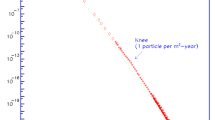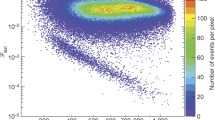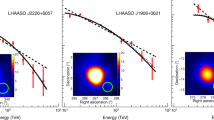Summary
A method which can be used for detecting the presence of high energy deuterons in the primary cosmic radiation is described. The suggested method takes advantage of the fact that when only the neutron of the incoming deuteron takes part in a collision and gives rise to a star in a nuclear emulsion, the proton continues in the forward direction almost undeviated. Such stars referred to as (d, p) stars, can provide evidence that the incoming particle is a deuteron. In order to use this method it is necessary to know: (i) the interaction mean free path λd of high energy deuterons in nuclear emulsions; and (ii) the proportionf(d, p) of deuteron induced interactions in which only the neutron takes part. These have been determined to be λd=15.8 cm andf(d, p)=0.4. The suggested method is applicable if deuterons constitute ≳5% of the singly charged particles in the primary radiation.
Riassunto
Si descrive un metodo che può essere usato per rivelare la presenza di deutoni di alta energia nella radiazione cosmica primaria. Il metodo suggerito trae origine dal fatto che quando solo il neutrone del deutone che arriva prende parte ad una collisione e dà origine ad una stella nell’emulsione nucleare, il protone continua in avanti quasi senza deviazione. Queste stelle, chiamate stelle (d, p), possono fornire la prova che la particella che arriva è un deutone. Per usare questo metodo è necessario conoscere: 1) il cammino libero medio di interazione λd dei deutoni di alta energia nelle emulsioni nucleari; e 2) la proporzionef(d, p) delle interazioni provocate dai deutoni, a cui prende parte il solo neutrone. Questi valori sono stati determinati in λd=15.8 cm ef(d, p)=0.4. Il metodo suggerito è applicabile se i deutoni costituiscono ≳5% delle particelle a carica singola della radiazione primaria.
Similar content being viewed by others
References
H. E. Suess andH. C. Urey:Rev. Mod. Phys.,28, 53 (1956).
M. V. K. Appa Rao, R. R. Daniel andK. A. Neelakantan:Proc. Ind. Acad. Sci.,43, 181 (1956).
G. Quareni andG. T. Zorn:Nuovo Cimento,1, 1282 (1955).
E. Lohrmann andM. W. Teucher:Phys. Rev.,115, 636 (1959).
S. Biswas, P. J. Lavakare, K. A. Neelakantan andP. G. Shukla:Nuovo Cimento (in course of publication).
The details on the stacks are given by:R. Cester, A. Debenedetti, C. M. Garelli, B. Quassiati, L. Tallone andM. Vigone:Nuovo Cimento,7, 371 (1958) and by:P. H. Fowler andC. J. Waddington:Phil. Mag.,1, 637 (1956). One of us (P. K. A.) wishes to thank Drs.Debenedetti andQuassiati of Torino andDrs. Perkins andWaddington of Bristol for making available the emulsion stacks and the scanning charts.
C. J. Waddington:Phil. Mag.,2, 1059 (1957).
We are thankful to Dr.W. H. Barkas of the University of California, U.S.A. for kindly giving us an emulsion plate exposed to the deuteron beam.
S. Hayakawa, K. Ito andY. Terashima:Suppl. Progr. Theor. Phys.,6, 1 (1958).
M. V. K. Appa Rao, S. Biswas, R. R. Daniel, K. A. Neelakantan andB. Peters:Phys. Rev.,110, 751 (1958).
S. F. Singer:Suppl. Nuovo Cimento,8, 549 (1958).
Author information
Authors and Affiliations
Rights and permissions
About this article
Cite this article
Daniel, R.R., Lavakare, P.J. & Aditya, P.K. A method for detecting the possible existence of high energy deuterons in the primary cosmic radiation. Nuovo Cim 17, 837–844 (1960). https://doi.org/10.1007/BF02732126
Received:
Published:
Issue Date:
DOI: https://doi.org/10.1007/BF02732126




